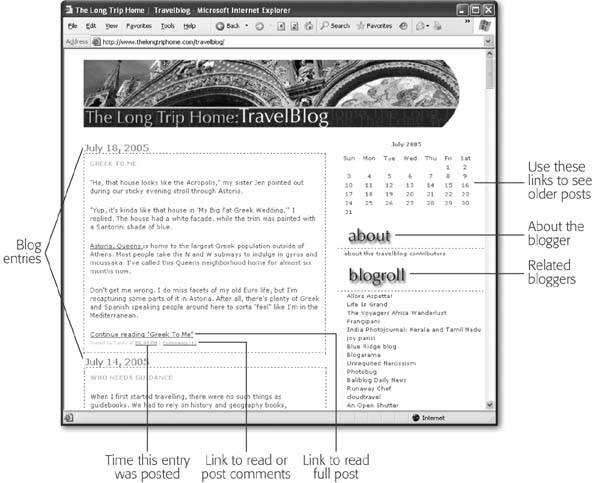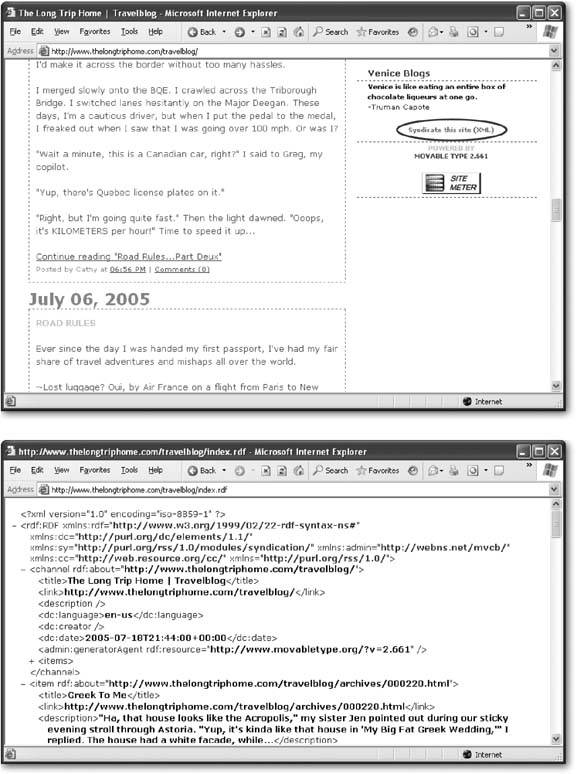Section 17.1. Understanding Blogs
The word "blog" is a nerdy abbreviation of Web log , which makes sense because blogs are made up of regular, dated blurbssort of like a cross between a diary entry and a newsgroup postings. "Blog" is also a verb, as in "I just ate at a terrible restaurant; when I get home I'm going to blog about it." Figure 17-1 dissects the anatomy of a basic blog.
|
Although blogs simplify Web posting, it's unfair to say that blogs are just a simplified way to work the Web. Rather, blogs are better understood as a wholly different form of online communication. And although there's no definitive test to decide what is and what isn't a real blog, there are several characteristics that most blogs share:
-
Blogs are personal . There are topic-based blogs, work-based blogs, and many more blogs filled with random, offbeat musings. However, blogs always emphasize the author's point of view. There's rarely any attempt to be objectiveinstead, blogs contain unapologetically idiosyncratic opinions . Blogs are always written in the first person.
-
Blogs are organized chronologically . When you design a Web site, you spend a great deal of time deciding how to best organize the material. Ideally, you need a menu or set of links that can guide the visitor through an assortment of different topics. Blogs take a radically different approach. They don't have any organization other than a loose, chronological ordering of postings. Anything else would just slow down restless bloggers.
-
Blogs are updated regularly . Blogs emphasize fast, free communication rather than painstakingly crafted Web design. Bloggers are known to add content obsessively (sometimes as often as hourly). Because blog entries are dated, it's glaringly obvious if you aren't keeping your blog up to date. If you can't commit to blogging regularly, don't start a blogjust set up a simple Web page instead.
-
Blogs are flexible . There's a bit of blog wisdom that says no thought's too small for a blog. And it's truewhether you want to write a detailed discussion about the viability of peanut -butter Oreos or a three- sentence summary of an uneventful day, a blog post works equally well.
-
Blogs create a broader conversation . Blogs form communities more readily than Web sites. Not only are blogs more conversational in nature, they also support comments and links that can tie different blogs together into a conversation. If an interesting item is posted in one blog, a legion of fellow bloggers often add links to it within hours. Scandalous blog gossip is known to rocket right around the globe in a startlingly short period of time.
Note: When a large amount of activity, information, and opinion erupts around a particular subject or controversy in the blogosphere , it's sometimes called a blogstorm , or blog swarm. You can find more blogtastic jargon at http://en.wikipedia.org/wiki/Weblog.
The actual content of a blog isn't fixedit can range widely, from political commentary to personal travelogues. There are hundreds of thousands of blogs online today. In fact, the Blogger service alone hosts several million blogs, of which several thousand are considered active blogs.
The best way to get a feeling for blogdom is to check out some popular examples. To see an example of widely read political commentary, surf over to arch-conservative Andrew Sullivan's blog at www.andrewsullivan.com. Or check out the insights of Salam Pax, the Baghdad blogger (now a Guardian columnist), who captivated the media world with a frank, gripping account of life in war-torn Baghdad at http://dear_raed. blogspot .com. For somewhat lighter fare, visit the curiously popular www.wilwheaton.net, a blog by Wil Wheaton, the actor who played the nerdy upstart Wesley Crusher of Star Trek fame. For expertise and observations from security guru Bruce Schneier, surf to www.schneier.com/blog. The list goes onfrom journalists to hobbyists to sports heroes and porn stars, it seems almost everyone's willing to psychoanalyze their life or chat about water- cooler topics with an audience of millions via a blog.
Tip: Blogs are a specialized niche that can't compete with a lot of the other types of sites you've seen. For example, you can't effectively sell a line of clothes for dogs on a blog. However, many people start blogs in addition to ordinary Web sites. This is a great combination. Visitors love blogs because they crave a glimpse behind the scenes. They're also sure to visit again and again if they can count on a regularly updated blog to offer a steady stream of news, gossip, and insights.
17.1.1. Syndication
One of neatest features about blogs is syndication . Syndication is a feature that allows avid blog readers to monitor their favorite blogs using a specialized program (called a feed reader , or news aggregator ). You fire up your feed reader, and enter links to all your favorite blogs. The feed reader periodically checks these blogs for new postings, and lets you know when they show up. Quite simply, a feed reader lets you stay up to date with all your friends in the blogiverse, without forcing you to surf back to every blog 94 times a day to check if anything's new. Feed readers are the only practical option if you need to follow lots of blogs regularly.
Note: Feed readers are a little like email programs, which, of course, let you regularly check to see if you have new messages from any of your friends. This is a lot more efficient than contacting them each individually and asking if they have anything new to say. Similarly, you can use a feed reader program whenever you want to check up on blog activity. If there's nothing new, you find out in an instant.
Although most blogs work with feed readers, some don't. In order to work with a feed reader, a blog needs to provide a feed (Figure 17-2). A feed contains recent blog postings in a computer-friendly format. Feed readers know to interpret feeds to get important information like the title, description, and date. Feed readers also use feeds to determine whether or not there are any new postings. Technically, feeds are in an XML-based format, because XML is a data standard that can be interpreted on any computer platform.
If you want to try using a feed reader, you've got lots of choices:
-
Online feed readers require a subscription, but you don't need to install anything. You read the feed right inside a Web browser window. Popular examples include www.bloglines.com, www. newsisfree .com, and www.newsgator.com.
-
Desktop feed readers run on your computer; you'll need to find a version that runs on your operating system. You can track down many desktop feed readers on popular shareware sites like www.zdnet.com. If you're using a Windows computer, you can purchase the excellent FeedDemon (see Figure 17-3) for a nominal fee. Mac fans might like the highly-touted NetNewsWire (which sells for around $25 at http://ranchero.com/netnewswire).
-
Browsers are increasingly adding features like feed reading. If you're using Firefox, you can use a feature called live bookmarks (see Figure 17-4) or you can download a more powerful feed reader plugin. The next version of Internet Explorer promises new feed-reading features, and the latest version of Apple's Safari browser has a feed reader built in.
|
Tip: For an article that describes different feed readers, see http://weblogs.about.com/od/aggregators.
|
17.1.2. Blog Hosting and Software
Before you can set up a blog, you need to understand the different kind of blogmaking options out there. There are really three types of blogs:
-
Hosted blogs . With a hosted blog, you simply sign up with a blog provider and start blogging. Adding a blog entry is as simple as just filling out a form in your Web browser. You never need to hassle with a separate program or figure out how to upload content files, because the blog provider stores all the HTML files for your blog on its Web servers. You don't even need to have a Web site. Hosted blogs are the best bet for new bloggers. They're completely painless and remarkably flexible.
Examples of hosted blog companies include MSN Spaces (http://spaces.msn.com), Radio UserLand (http://radio.userland.com), TypePad (www.typepad.com), Live Journal (www.livejournal.com), and Xanga (www.xanga.com).
-
Self-hosted blogs . If you're a hardcore high-tech geek and you have a Web server in the basement , you might be interested in hosting a blog entirely on your own. In order to do this, you need to find some blog hosting software that works on your Web server platform, install it on your Web server, and configure everything correctly. This approach gives you unlimited flexibility (and it may get you better performance). However, it probably isn't for you unless you enjoy do-it-yourself challenges like making your laptop talk to your coffee maker.

Figure 17-4. Top: When Firefox detects a link to an XML feed in the current page, it shows a special icon in the status bar. Click this icon to add a live bookmark.
Bottom: Live bookmarks provide a submenu with current blog posts, which gets updated automatically. You still need to check the bookmark to see if there's a new post (which requires more effort than a feed reader like FeedDemon), but you don't need to keep visiting the original site.
Examples of blogging software include Movable Type (www.movabletype.org), Blosxsom (www. blosxom .com), and WordPress (http://wordpress.org).
-
Remote weblog systems . This category is really a hybrid between hosted blogs and do-it-yourself blog hosting software. The basic idea is that you use a blogging system that's hosted by a blog provider, and you have the option to choose where you want to store the final blog files. You can choose to host them with the blog provider (in which case, this option is the same as an ordinary hosted blog), or you can ask the blogging system to transmit any updates to your own Web server. This model gives you the ease of hosted blogs along with some extra features (like the ability to place your blog on a part of your Web site).
Examples in this category include Blogger (www.blogger.com), the blog software demonstrated in this chapter, and WebCrimson (www.webcrimson.com).
In this chapter, you'll spend your time using one blogging tool, called Blogger. Blogger is simple to use yet powerful, which makes it the best candidate for all-around blogging champ.
EAN: N/A
Pages: 135
- An Emerging Strategy for E-Business IT Governance
- Assessing Business-IT Alignment Maturity
- Linking the IT Balanced Scorecard to the Business Objectives at a Major Canadian Financial Group
- A View on Knowledge Management: Utilizing a Balanced Scorecard Methodology for Analyzing Knowledge Metrics
- Governing Information Technology Through COBIT


